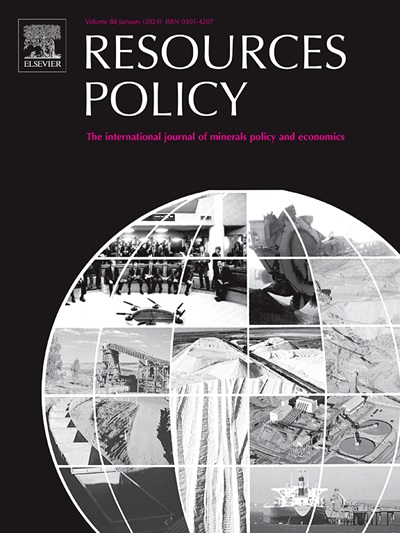三大核心矿产资源、能源不确定性和包容性数字化对经济增长的非线性影响:中美比较分析
IF 10.2
2区 经济学
0 ENVIRONMENTAL STUDIES
引用次数: 0
摘要
本研究探讨了矿产资源(石油、煤炭和天然气)、数字化和能源不确定性对中国和美国经济增长的非对称影响。利用 2000 年至 2022 年的季度数据,我们采用非线性自回归分布滞后(NARDL)模型来分析这些关系。研究首先进行单位根检验、协整分析和不对称检验,以建立变量之间的稳健联系。长期和短期结果证实了非对称性的存在,因为石油租金、数字化和能源不确定性的正负冲击对经济增长的影响是不同的。值得注意的是,石油租金和数字化的正向冲击有利于经济增长,这表明石油租金的增加和数字包容性有助于经济发展。相反,能源不确定性的正向冲击往往会降低经济增长。有趣的是,中国和美国的研究结果显示了类似的非对称模式;煤炭和天然气租金对经济增长产生了积极影响,而控制变量表明,资本和劳动力的增加促进了两国的发展。误差修正项,中国为 0.731(73.1%),美国为 0.625(62.5%),表示非对称差异的年修正率。所有诊断测试都证实了 NARDL 模型适用于本研究。最后,本研究揭示了所有变量对之间显著的双向因果关系。本文章由计算机程序翻译,如有差异,请以英文原文为准。
Non-linear effects of three core mineral resources, energy uncertainty, and inclusive digitalization on economic growth: A comparative analysis of US and China
This study examines the asymmetric effects of mineral resources (oil, coal, and gas), digitalization, and energy uncertainty on economic growth in China and the USA. Using quarterly data from 2000 to 2022, we employ the nonlinear autoregressive distributed lag (NARDL) model to analyze these relationships. The study begins by conducting unit root tests, cointegration analysis, and asymmetry tests to establish robust connections between the variables. The long- and short-run results confirm the presence of asymmetry, as positive and negative shocks in oil rents, digitalization, and energy uncertainty affect economic growth differently. Notably, positive shocks in oil rents and digitalization favour economic growth, indicating that increases in oil rents and digital inclusion contribute to economic development. Conversely, positive shocks in energy uncertainty tend to reduce economic growth. Interestingly, the findings for China and the USA show similar asymmetric patterns; coal and natural gas rents positively influence economic growth, while the control variables suggest that capital and labour increase contribute to both countries' development. The error correction terms, 0.731 (73.1%) for China and 0.625 (62.5%) for the USA, indicate the annual rate at which asymmetric discrepancies are corrected. All diagnostic tests confirm the suitability of the NARDL model for this study. Finally, the study reveals significant bi-directional causality among all pairs of variables.
求助全文
通过发布文献求助,成功后即可免费获取论文全文。
去求助
来源期刊

Resources Policy
ENVIRONMENTAL STUDIES-
CiteScore
13.40
自引率
23.50%
发文量
602
审稿时长
69 days
期刊介绍:
Resources Policy is an international journal focused on the economics and policy aspects of mineral and fossil fuel extraction, production, and utilization. It targets individuals in academia, government, and industry. The journal seeks original research submissions analyzing public policy, economics, social science, geography, and finance in the fields of mining, non-fuel minerals, energy minerals, fossil fuels, and metals. Mineral economics topics covered include mineral market analysis, price analysis, project evaluation, mining and sustainable development, mineral resource rents, resource curse, mineral wealth and corruption, mineral taxation and regulation, strategic minerals and their supply, and the impact of mineral development on local communities and indigenous populations. The journal specifically excludes papers with agriculture, forestry, or fisheries as their primary focus.
 求助内容:
求助内容: 应助结果提醒方式:
应助结果提醒方式:


